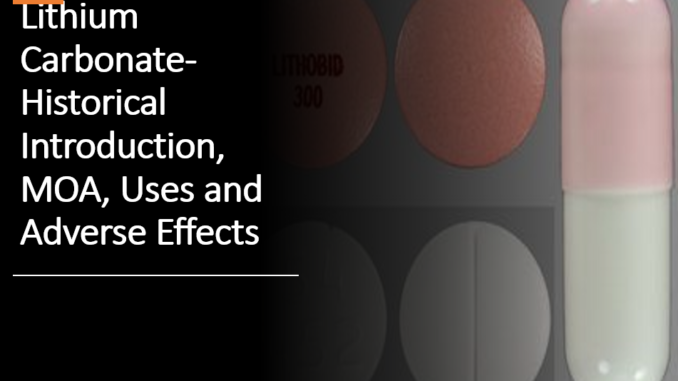
- Lithium carbonate has been used clinically for 70 years to treat bipolar disorder. It is the first line treatment for manic phases of bipolar disorder.
- Molecular formula- Li2CO3
Historical Introduction
- In 1949, an Australian Psychiatrist- John Cade, initiated a new era in psychiatric treatment by using lithium carbonate to treat mania. He thought that mental illness may be due to excess or deficiencies of unidentified chemical substances, including nitrogenous substances. Inspired by this idea, he gave lithium carbonate to laboratory animals and noticed calmness and other behavioral changes. After this, he also reported beneficial effects of lithium carbonate on 10 patients suffering from mania. However, it was not adopted as effective therapy in psychiatry immediately.
- In 1954, Professor Erik Strömgren, an academic psychiatrist at the University of Aarhus Medical Center in Denmark, came to know about Cade’s experience with lithium. He asked his junior colleague Mogens Schou to replicate the Australian findings. Schou did intensive research in collaboration with other psychiatrists and found out about safe and effective clinical use of lithium carbonate in treatment and prevention of recurrence of manic-depressive illness.
- Some other researchers found out about prophylactic use of lithium carbonate.
- Gradually, it became accepted in clinical practice around the world. Its clinical applications were made feasible by introducing reliable and sensitive methods of monitoring serum concentration of lithium.
- Today, it is considered as gold standard treatment for maintenance treatment in bipolar disorder.
Mechanism of action
Exact mechanism of action is not known. It causes:
- Modification of GABA (Gamma Amino Butyric Acid) in brain and modulation of synaptic glutamate availability.
- Decrease in synthesis of dopamine and noradrenaline and facilitate their neuronal re-uptake.
- Inhibition of phospholipase C synthesis.
- Decrease in function of brain protein kinases resulting in alteration in release of neurotransmitter and hormones.
Pharmacokinetics of lithium carbonate
- Administered through oral route. It is well absorbed and gets distributed throughout the body water.
- As it is metallic ion, it is neither metabolized nor bind to protein. Excretion takes place through urine.
Uses of lithium carbonate
- To treat acute episodes of mania in combination with anti-psychotics.
- To prevent the recurrence of mania and depressive episodes in bipolar disorder.
- In alcohol dependence.
Adverse effects of lithium carbonate
- Lithium carbonate, when taken in small doses is not harmful. However, when taken in excessive amount, lithium toxicity may occur. The required dosage may vary according to age, health condition of patient and sensitivity to lithium ions. In older patients, its dose should be 20 % lower than in younger patients.
- Mild toxicity includes drowsiness, GI disturbances, muscular weakness, allergic reactions, blurred vision, polyuria and weight gain. Large doses may cause sodium depletion, tremors, ataxia, cardiac arrythmia, seizures and coma. Chronic administration may cause ECG changes, goiter formation, hypothyroidism (rare). It is embryotoxic and may cause Ebstein’s anomaly (complex, congenital heart defect).
- Lithium should not be administered in patients with acute myocardial infarction and acute renal failure. It should be administered with care in patients with cardiac arrythmia, reduced kidney function, psoriasis, Addison’s disease, certain neurological disorders, myasthenia gravis and epilepsy. It should not be administered with diuretics.
- Mild adverse effects are common which may subside on lowering the dose. In severe cases, physician may recommend cessation of therapy. In case of fever or other health condition, patient should take advice form concerned physician. Well- balanced diet and enough water should be taken to minimize side effects.
- Because of its various complications, it should be taken under medical supervision only and blood level of lithium should be continuously monitored.
Lithium in pregnancy and post-partum
- Doctor and patient should discuss risks and benefits of continuing, reducing dose or stopping therapy in pregnancy, before delivery and after delivery including breast feeding.
- If it is prescribed during pregnancy, serum concentration should be monitored monthly and weekly in third trimester. It is not necessary to stop lithium before or after delivery. However, serum concentration should be measured twice in a week for few weeks after delivery.
- If a pregnant woman with bipolar disorder discontinue lithium therapy, she should restart it immediately after delivery. It is because of high chances of recurrence of depression and bipolar disorder in early post-partum period.
- Breast feeding during lithium treatment is not recommended.
- While discontinuing lithium, it should be done gradually.
Disclaimer- This article is for informative purpose only and should not be used as a replacement for expert medical advice.
References
- https://psychologenie.com/lithium-carbonate-side-effects
- https://www.brainreference.com/lithium-carbonate-review/
- Tondo L, Alda M, Bauer M, Grof P, Bergink V, Hajek T et al. Clinical use of lithium salts: guide for users and prescribers. Int J Bipolar Disord. 2019; 7(16): 1-10.
- Gitlin M. Lithium side effects and toxicity: prevalence and management strategies. Int J Bipolar Disord. 2016; 4(27): 1-10.
- Pharmacology and Pharmacotherapeutics. 24th edition.